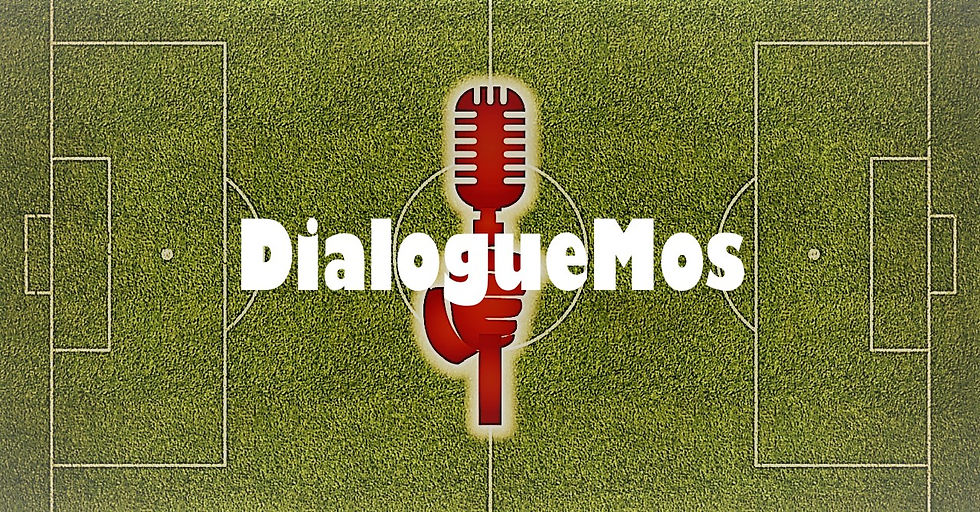Speaking with Don Bisca
- Iván

- Jun 5, 2022
- 6 min read
Updated: Jun 6, 2022

I have known him forever. Or so I thought until I had the opportunity to talk to him. I 'discovered' him many years ago while I was zapping in search of a television program of my interest. He was not the leading voice of that sports broadcast, but his opinions and tactical views on that Spanish League soccer match were striking to me. His mastery of the subject, coupled with his style of explaining each action of the game, kept me 'hooked' until the end.
Who was that voice with a distinctly Argentine tone, breaking down every aspect of the match with almost surgical precision? Was it even possible to handle so many statistics or have records on any of the teams on the field? How did he manage to fuse his cultural baggage with a single match? Or, simply put, who was this man the narrator called Don Bisca?
Born in the city of Buenos Aires more than five decades ago, Eduardo came to journalism because of his unquenchable thirst to turn moments into images and with them tell stories. He felt a kind of idyll for photography. Influenced by El Gráfico magazine, a sort of endless source of snapshots with a high historiographic value -as he himself defines it-, he entered the world of negatives and laboratories full of red lights.
He came to journalism because of his unquenchable thirst to turn moments into images and use them to tell stories.
His passion for sports such as cycling, soccer or athletics led him to capture stills with high artistic and informative value. Some of them were star shots, even in the magazine that inspired him. Like the goal scored by Hernán Crespo for River Plate to defeat Argentinos Junior in the 1994 Apertura Tournament. Others, no less important, were published in Atletismo Argentino, a space that is still published in his native country and that brought him to Havana in the distant year of 1991 to cover the XI Pan American Games. There, in the cuban capital, he took the pulse of an entire nation and got to know closely who would later become one of his sports idols, the runner Ana Fidelia Quirot.
(1) Argentine jumper Andrea Avila poses for El Grafico magazine in March 1995. (2) Striker Hernán Crespo celebrates the goal that gave River Plate the victory over Argentinos Junior. Cover of El Gráfico, September 26, 1994. (3) Celebration of Cuban runner Ana Fidelia Quirot, after winning the silver medal in the 800 meters at the XXVI Olympic Games in Atlanta 1996. Images extracted from Eduardo Biscayart's personal web page.
Ana Fidelia passed in front of where I was standing with her flag held high and with an uncontainable joy, a smile as big as her achievement. It was a unique moment that I was able to capture and that I turned into one of my favorite snapshots.
The story of the also known as the Caribbean Storm, of proven worth in the field and track, but agigant after recovering from a domestic accident that caused countless injuries to her body, motivated him to follow her closely. To have her always 'framed' in his lens. After winning the silver medal in the double oval lap during the XXVI Olympic Games in Atlanta 1996, "Ana Fidelia passed in front of me with her flag held high and with an uncontainable joy, a smile as big as her achievement. It was a unique moment that I was able to capture and that I turned into one of my favorite snapshots", he says.
Eduardo Biscayart defines himself as privileged to have the opportunity to tell the stories that emanate from sports. 'Loaded' of many of those experiences came to the news network CNN in its Spanish version. There he began to write and to know the particularities of the audiovisual field. With a little more experience between lights and cameras he arrived at the production department of the sports television station ESPN. It was 1997, and he was already surrounded by relevant voices such as Ricardo Ortiz, Diego Balado, Kike Wolf or Luis Omar Tapia.
Tapia perceived the talent of that thin, bespectacled South American and recommended him to try out as a commentator. Thus, began to be forged not only one of the most prominent and popular duets of those times, but also a friendship that lasts until today. Biscayart became Don Bisca for his partner and the soccer world. "We shared many codes of work and life that fostered a very strong bond, an unusual closeness and complicity", he admits. Listening to them during the transmissions of the Spanish League or the Champions League was a total enjoyment, a dose of knowledge impossible to ignore.
Don Bisca and Luis Omar Tapia formed one of the most popular duos in the late 90's. FOX Sports brought them together again, but this time they were accompanied by Diego Balado. Therefore, 'The Three Musketeers' were born. Photos taken from Internet.
His departure from ESPN led him to other professional paths. More than a few television networks sought his services and knowledge. His voice was heard in several Soccer World Cups (2002, 2006, 2014), EuroCup (2008), America's Cup Soccer (2007) and international leagues such as the Italian or the top 'champions'. For those inexplicable things of destiny, it was the maximum competition at club level, but now from the microphones of FOX Sports, the one in charge of bringing him together again with his dear friend Luis Omar and his fellow countryman Diego Balado. There they formed a luxury team known among the audience as 'The Three Musketeers'.
The 2018 UEFA Champions League final, in the beautiful city of Kiev, I keep in my memory with great fondness, because we discovered its history, its people and its culture and, above all, because it was the last match we played together.
Working together, he says, became easy and something we really enjoyed. We could do things with our eyes closed. A glance or just a sign would indicate when to enter or leave the dialogue without interrupting us. Luis' witty jokes made the days more pleasant. We shared, he recalls, many emotional moments and many championship league finals. With a certain nostalgic tone in his voice, he recalls that of 2018 in the beautiful city of Kiev. "We discovered its history, its people and its culture. But above all, I keep it fondly in my memory because it was the last match we broadcast together until now," he concludes.
It seems almost an indecipherable mystery for those of us who have the privilege of having seen him on television, and those of us who currently follow him in his project Fútbol Infinito, of which he is co-founder together with his colleague Jaime Macías, to know how he 'feeds' this privileged mind, how he elaborates his comments based on stories and curious facts. For this fan of Newell's Old Boys (a club from Rosario that plays in the first division of Argentine football) there is no possible method or secret. "It's all about, he says, studying the teams and their players, the tactical moves, the historical and statistical data; being informed about the news and also the rumors; and, most importantly, respecting the match, which is always much more important and interesting than those who tell it".
In the soccer's world, Don Bisca is an ace with numbers. He handles them with such ease that they almost seem like a game to him. But his voracious mind is not only fed by figures. He enjoys good music, art and poetry. He has a gift, and it is his sapience, and that unlimited capacity to nourish himself from everything that surrounds him, tie it well, and 'prepare' an analysis as meticulous as it is delicious. The success he enjoys today is the result of constant improvement, of the work of good teachers who taught him about voice-over, writing, camera work and expression. And, also, he owes much to that inexhaustible source of passion and enjoyment for what he does. That daily drive that allows his machinery to never stop.
... have a high sense of self-criticism, look for models to guide them and reproduce certain codes or ways of doing things, and value opportunities and those who give them to them.
That is why he recommends to those who discover themselves in journalism to be dedicated, to have a high sense of self-criticism, to look for models to guide them and to reproduce certain codes or ways of doing things, and to value opportunities and those who give to them. This work we do has a lot of craft and profession; it is a perfect blend of both, he says, because we narrate facts of life, trying to explain them and at the same time understand them. Although I am not good at giving advice, he says, it has worked for me in my career.
Eduardo Biscayart or Don Bisca, because many years ago he lost his first name for good in the television field, is one of those people with whom we talk and time seems to stop. Every idea he proposes leads you to imagine him in his immeasurable comments or rummaging through his endless Biscapedia, as his friend Luis Omar Tapia also calls his wonderful mind. It is hard to miss him and his inseparable Portos (Tapia) and Aramís (Diego Balado) in the soccer broadcasts. There were so many good moments that we miss seeing him standing in front of the microphone, elegant and distinguished as always, ready to give his accurate opinions. For better or for worse, we always have the memory of the good things. And you, Don Bisca, are one of the good ones.



















Comments